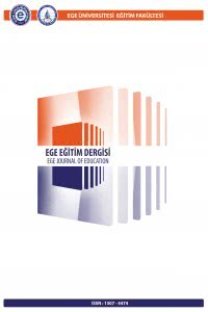Buharlaşma ve Kaynama Konularındaki Kavram Yanılgılarının Önlenmesinde Analoji Yönteminin Etkisi
Kavram Yanılgısı, Analoji, Buharlaşma, Kaynama
The Effects of Using Analogies to Prevent Misconceptions About Evaporation And Boiling
-,
___
- Ayas, A. , Özmen, H. ve Çoştu, B. (2001). Lise öğrencilerinin buharlaşma kavramı ile ilgili anlamalarının belirlenmesi. Hacettepe Üniversitesi Eğitim Fakültesi Dergisi, 18, 201-210.
- Bar, V. & Travis, A. (1991). Children’s views concering phase changes. Journal of Research in Science Teaching, 28, 363-372.
- Bar, V. & Gaglili, I. (1994). Stages. of children’s views about evaporation. International Journal of Science Education, 2, 157-154.
- Bergguist, W. & Heikkinen,H.W. (1990). Student ideas Regarding Chemical Equilibrium . Journal of Chemıcal Educatıon, 67, 1000-1003.
- Bilgin, İ. ve Geban. Ö. (2001). Benzeşim yöntemi kullanılarak lise 2. sınıf öğrencilerinin kimyasal denge konusundaki kavram yanılgılarının giderilmesi. Hacettepe Üniversitesi Eğitim Fakültesi Dergisi, 20, 26-32.
- Blosser, P. (1987). Secondary school students' comprehension of science concepts: Some findings from misconceptions research. Columbus, Ohio: SMEAC Science Education Digest No. 2. (ERIC Documentation Reproduction Service No. ED. 286 757).
- Boo, H. K. (1998). Students’ understanding of chemical bonds and the energetic of chemical reactions. Journal of Research in Science Teaching, 35, 569–581.
- Chang, J. (1999). Teachers college students’ conceptions about evaporation, condensation, and boiling. Science Education, 15, 512-526.
- Fısher, K. M. (1985). A misconception ın biology: Amino acids and translation. Journal of Research in Science Teaching, 1, 53-62.
- Gorin, G. (1994). Mole and chemical amount. Journal of Chemical Education, 71, 114–116.
- Griffiths, A. K. & Preston, K. R. (1992). Grade-12 students’ misconceptions relating to
- fundamental characteristics of atoms and molecules. Journal of Research in Science
- Teaching, 6, 611-628.
- Hackling, M. W. & Garnett, P. J. (1985). Misconceptions of chemical equilibrium.
- European Journal of Science Education, 7, 205-214.
- Jones, B. L. (1984). How solid is a solid: Does ıt matter? Research in Science Education. 14, 104-113.
- Jones, B. L. & Lynch, P. P. (1989). Children’s understanding of the notions of solid and
- liquid in relation to some common substances. International Journal of Science
- Education. 11(4), 417-427.
- Johnson, P. (1998). Children's understanding of changes of state involving the gas state.
- Partn1: Boiling water and the particle theory. International Journal of Science
- Education 20, 5, 567-583.
- Nelson, P. G. (1991). The elusive mole. Education and Chemistry ,28, 103–104.
- Osborne, R. J. & Cosgrove , M.M.( 1983). Childrens’ conceptions of the changes of states of water. Journal of Research in Science Teaching, 9, 825-835
- Özdemir, A. ve Geban,Ö. (1998). Kavramsal değişim yaklaşımı ve kimyasal denge. "Eğitim' 97-98. Ankara: TED Ankara Koleji.
- Özmen, H. ve Demircioğlu,G. (2003). Asitler ve bazlar konusundaki öğrenci yanlış anlamalarının giderilmesinde kavramsal değişim metinlerinin etkisi. Milli Eğitim Dergisi. 159, 111-119.
- Özmen, H. (2005). Kimya öğretiminde yanlış kavramlar: Bir literatür araştırması, Türk Eğitim Bilimleri Dergisi.3(1), 23-43.
- Peterson, R., & Treagust,D. F. (1989). Grade-12 students’ misconceptions of covalent bonding and structure. Journal of Chemical Education, 66, 459–460.
- Russell, T., Harlen, W. & Watt, D. (1989). Children’s ıdeas about evaporation. International Journal of Science Education. 11, 556-576.
- Skamp, K. (1999). Are atoms and molecules too difficult for primary children? School Science Review. 81(295), 87-96.
- Stavy, R.( 1990). Children’s conceptions of changes in the state of matter: from liquid to gas. Journal of Research in Science Teaching, 3, 247-266.
- Stavy, R. ( 1991). Using analogy to overcome misconceptins about conservation of matter. Journal of Research in Science Teaching, 4, 305-313.
- Stieff, M. & Wilensky, U (2005). Connected chemistry : Incorporating ınteractive simulations into the chemistry classroom. Journal of Science Education and Technology, 3, 285-302.
- Treagust, D. F. (1988). Development and use of diagnostic tests to evaluate students’ misconceptions in science. International Journal of Science Education. 10(2), 159.
- Tsai, C.C. (1999). Overcoming junior high school student’s misconceptions about microscopic views of phase change. Journal of Science Education and Technology,1, 83-91.
- Tytler, R. (2000). A comparison of year 1 and Year 6 students’ conceptions of evaporation and condensation: dimension of conceptual progression. International Journal of Science Education. 22, 447-467.
- Yağbasan, R. ve Gülçiçek, Ç. (2003). Fen öğretiminde kavram yanılgılarının karakteristiklerinin tanımlanması. Pamukkale Üniversitesi Eğitim Fakültesi Dergisi, 13, 102-120.
- ISSN: 1307-4474
- Yayın Aralığı: Yılda 3 Sayı
- Başlangıç: 2001
- Yayıncı: Ege Üniversitesi Eğitim Fakültesi
Öğretmen Adaylarının Ekolojik Ayak İzlerinin Hesaplanması ve Değerlendirilmesi
Özgül KELEŞ, Naim UZUN, Sibel ÖZSOY
Rol Yapma ve Drama Etkinlikleriyle Yabancılara Türkçe Öğretiminde Motivasyonun Sağlanması
İki Farklı Öfke Ölçeğinin Çocuk ve Ergenler İçin Psikometrik Özelliklerinin İncelenmesi
Serap Tekinsav SÜTÇÜ, Arzu AYDIN
Özel Eğitim Öğretmenlerinin Bilgisayar Tutumlarının İncelenmesi
Göz Hareketleriyle Duyarsızlaştırma ve Yeniden İşleme: Yaklaşımın Etkililiği ve Bugünkü Durumu
BÖTE ÖĞRENCİLERİNDEKİ YARATICILIK ve PROBLEM ÇÖZME BECERİLERİNİN KARŞILAŞTIRILMASI
Mustafa Murat İNCEOĞLU, Aytek KOŞAR
İlköğretim Birinci Kademede Eğitimde Motivasyon Ölçeğinin Türkçeye Uyarlanması
Buharlaşma ve Kaynama Konularındaki Kavram Yanılgılarının Önlenmesinde Analoji Yönteminin Etkisi
